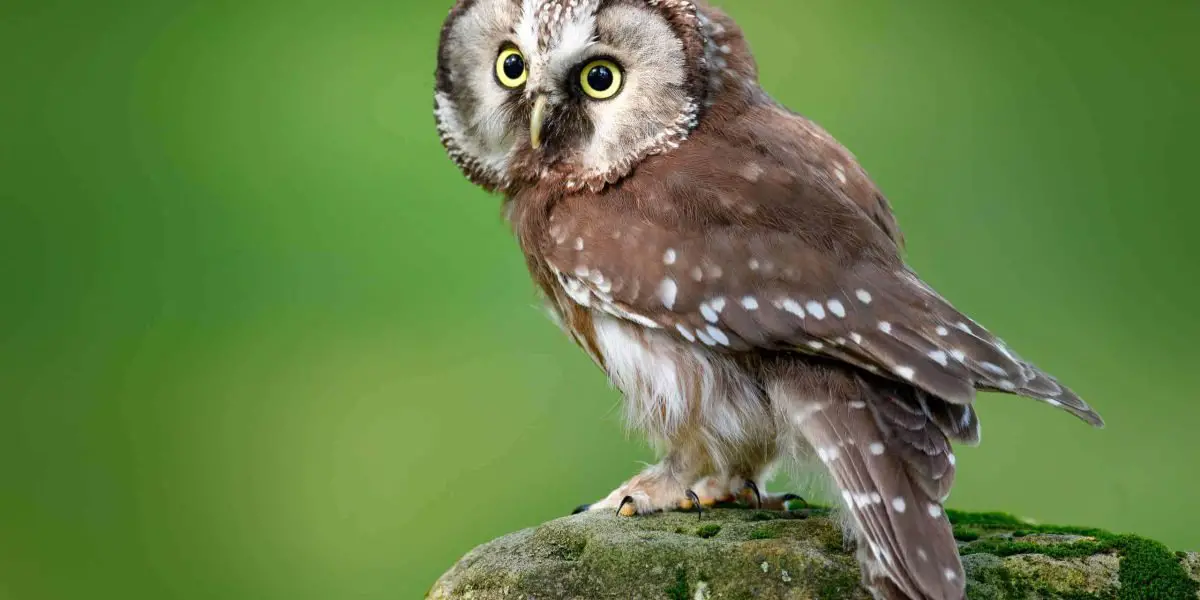
Want to learn more? This National Geographic Book on Owls is a great read!
The most common of these owl species in Colorado is the Great Horned Owl.
The state of Colorado has a diverse number of climates that differ depending on the region. The three main climates are continental, sub-tropical and sub-arctic.
There are 41 different state parks in Colorado and there are 4 different National Parks. Cherry Creek State Park is a popular birding spot and is also a great place to see the Burrowing Owl.
Now that we’ve talked about Colorado, lets look at some more in depth information about each of these owl species.
Want to attract Owls to your yard? Take a look at our article!
What Owls can be seen in Colorado?
Table of Contents
1. Barn Owl
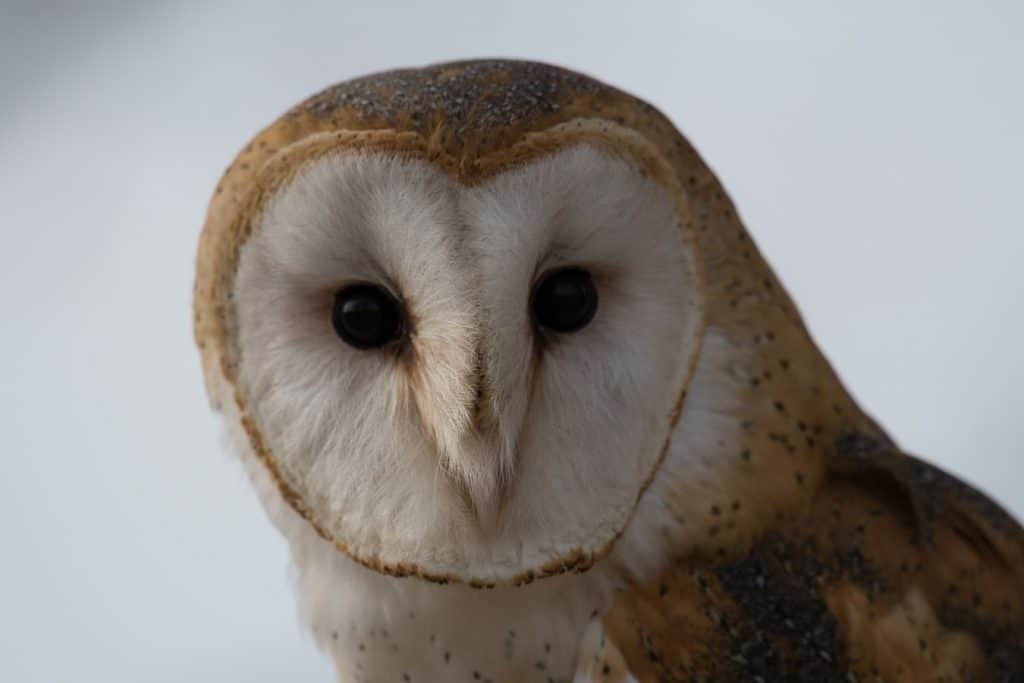
Wingspan
107 to 110 cm
Weight
430 – 620 g
Life Expectancy
Up to 4 years
Diet
Voles, Shrews & Mice
The Barn Owl is covered in pale feathers and is medium sized for an owl.
Their head and wings are covered with buff and grey feathers. However, in the night-time these feathers can appear to be completely white.
These birds have a wide range going from southern Canada to across 48 states in the USA.
Barn Owls are monogamous during the breeding season and most of these owls appear to mate for life.
Females will prepare the nests for egg incubation whilst the male will protect the nests and also bring her food.
Whilst these birds are territorial to other bird species, they will happily share hunting grounds with different Barn Owls.
You are most likely to see one of these birds hunting over open grasslands during the night.
Barn Owls are one of the more common owl species that you may see in Colorado.
They are permanent residents of the state and are found there throughout the year.
You can also see them across the whole state. The most recorded nest locations seem to occur in the south east of the state, but they have been seen frequently in every region.
2. Flammulated Owl
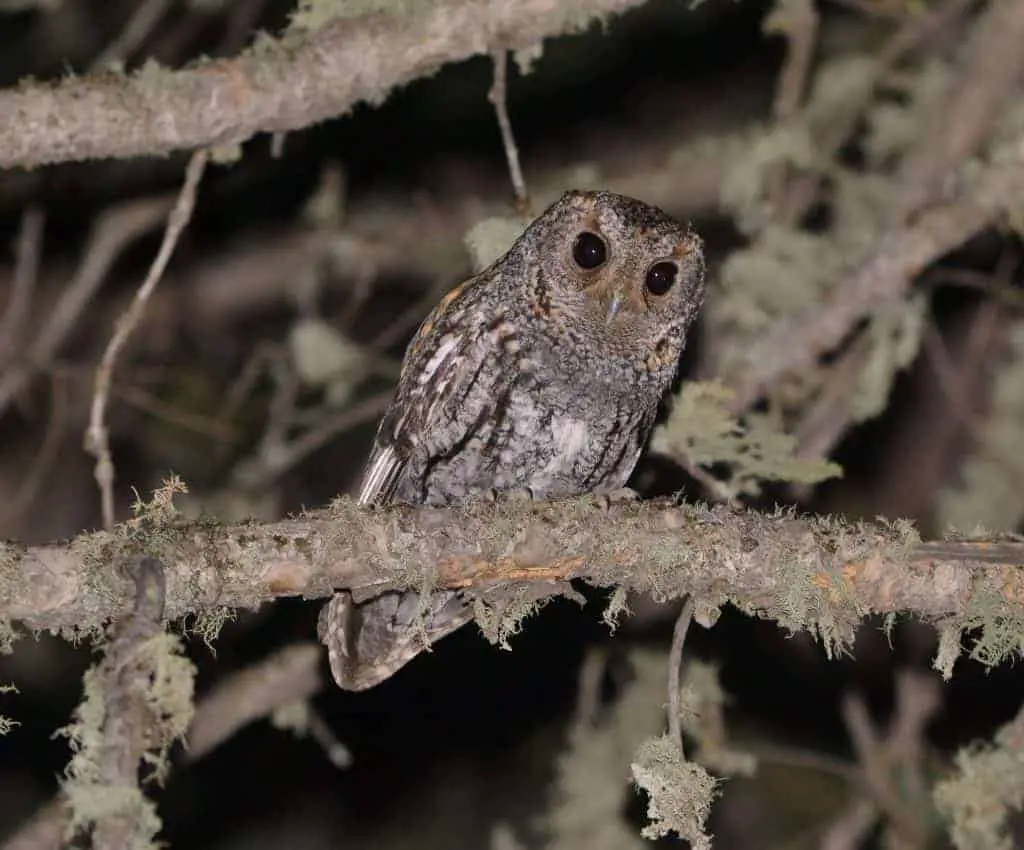
Wingspan
14inches
Weight
60g
Life Expectancy
8 years
Diet
Mostly insects
The Flammulated Owl has feathers of grey and rust colours. They are very small in size for an owl and can easily camouflage themselves against dense trees.
These birds are monogamous and many of them, about three quarters, will stay in long term breeding pairs.
Flammulated Owls are very territorial and defend large territories of about 5-6 acres.
They will chase other owls away from their territories, but it is very rare that a fight will occur between two individuals.
Not a lot is known about the wintering behaviour of this bird, but it appears that they spend these colder months in Mexican forests.
You are most likely to find these birds in forest habitats, usually more dense and coniferous habitats as that is their preferred area to nest.
These birds are mainly only seen in Colorado during their breeding seasons. They are not permanent residents of the state and can only be seen in certain regions.
The recorded sightings of Flammulated Owl nests have been in the central regions of the state.
You will not see these owls in Colorado during the colder winter months.
3. Eastern Screech Owl
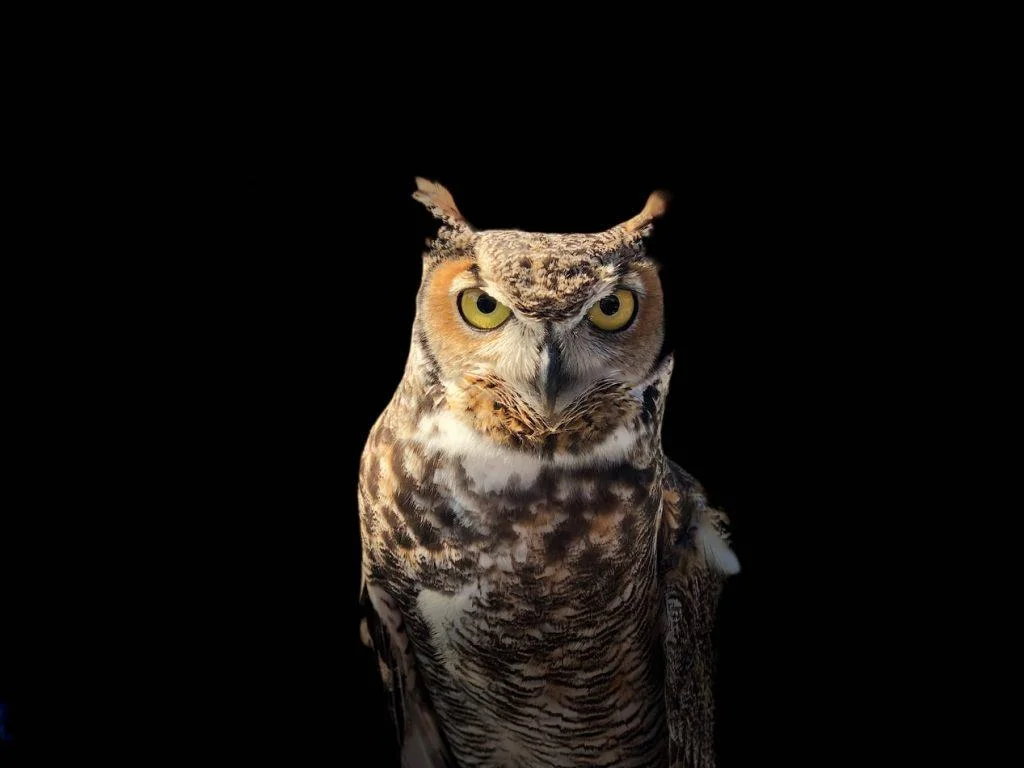
Wingspan
46 to 61 cm
Weight
160 g
Life Expectancy
14 years
Diet
Rats, Squirrels, Rabbits & Skunks
The Eastern Screech-Owl has a small stocky body and grey feathers and they look very similar to the Western Screech-Owl.
Males are believed to mate with several females during the breeding season, but they will form a pairing with one individual to help them raise the brood.
These pairings are also not a long-term thing and will change every year.
Females will stay in the nest and incubate the eggs whilst males spend most of their time defending their territory.
These birds have adapted well to suburban areas and have successfully bred in city parks and farmland.
They also appear happy to use manmade bird boxes, although they prefer to stay in dense forest areas.
In Colorado, these birds are year-round residents. However, they are only found in small areas of the state and are only seen across the eastern border.
They seem to have more abundant sightings in the north east areas of the Colorado border.
4. Western Screech Owl
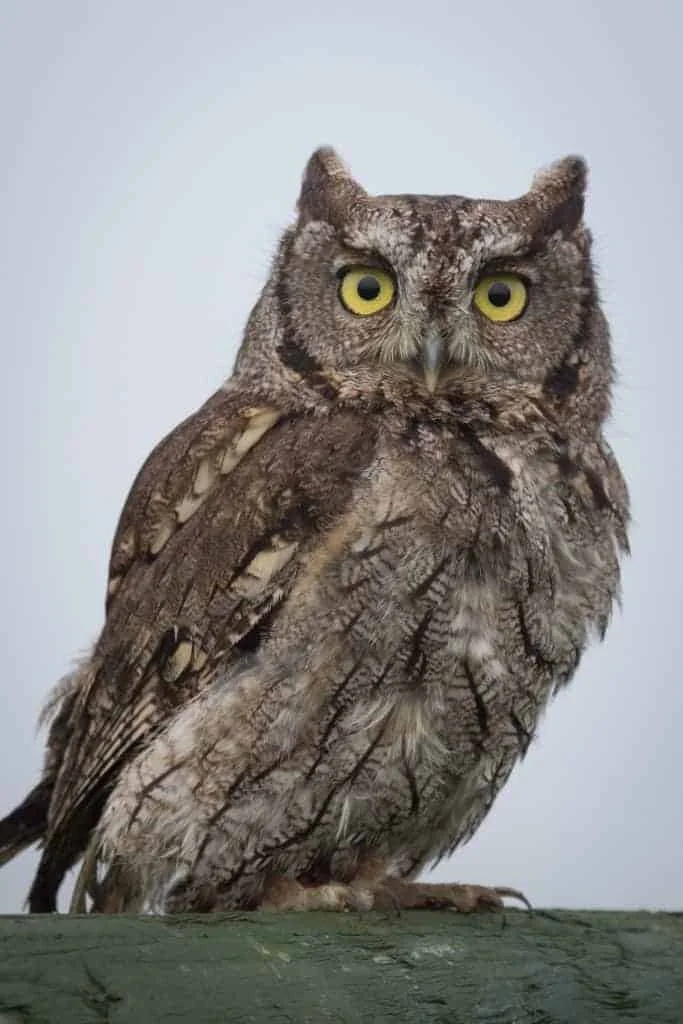
Wingspan
55cm
Weight
143g
Life Expectancy
13 years old
Diet
Insects and small mammals
The Western-Screech Owl has a stocky, small body that is covered with grey feathers.
These birds like to make their nests in open woodland areas, particularly along the edges of canyons.
In recent years they have also been observed staying close to urban cities.
Males will mate with several females during the breeding season but will still form a breeding pair with a single individual so that they can raise the brood together.
When courting a female, a male will bring food to the nest which is usually inside of a natural tree cavity.
Breeding pairs will also sing duets together and will both contribute to protecting the nest. One common bird that tries to disturb their nests is the crow.
The Western Screech-Owl is a permanent resident of the state in certain regions of Colorado.
You are likely to see these birds to the south west of the state throughout the year.
There have also been a number of recorded sightings of this owl in the south east of the state. You are very unlikely to9 see this bird in the north of Colorado.
5. Great Horned Owl

Wingspan
~140cm
Weight
1.4 kg
Life Expectancy
28 years old
Diet
Squirrels, Rabbits & Skunks
This owl has long pointed ears that look like horns, which is where it gets its name from.
They are large owls and their feathers are thick and greyish brown in colour.
Great Horned Owls will form long term breeding pairs and a lot of the time these pairs will stay close to each other outside of the breeding season.
They remain monogamous during mating seasons.
Both members of the breeding pair are very territorial and will defend their territory with a series of sharp hoots.
Fights will often break out and breeding pairs have been known to kill members of their species that stray too close to their nests.
Different bird species, such as crows, will also harass these birds in an attempt to get them to abandon their nests and their eggs.
This is one of the most abundant and widely distributed species of owl.
They are also the most common species of owl in Colorado. Great Horned Owls are year-round residents in Colorado and they can be found across the entirety of the state.
The most abundant number of sightings appears to be in the western half of the state.
6. Northern Saw-whet Owl
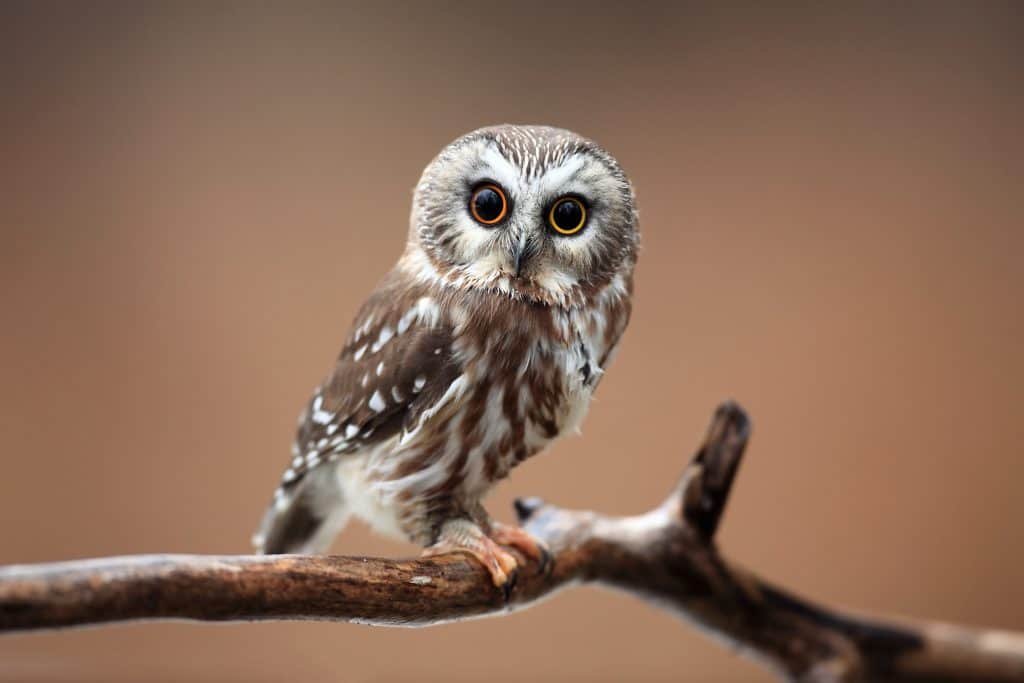
Wingspan
40 - 60 cm
Weight
100 g
Life Expectancy
7 years
Diet
Small birds, young squirrels, voles & shrews
The Northern Saw-whet Owl is covered in deep brown feathers and is small in size for an owl.
These small owls make their nests in various forest habitats and roost throughout the day.
Males will sometimes mate with several different females during the breeding season, but these birds are primarily monogamous and will form breeding pairs.
These breeding pairs change from year to year but they will often stay together outside of the breeding season to help each other defend their territory.
Their breeding season is from the end of January to the beginning of May which is when you will hear their distinct too-too-too mating call.
When a female enters a male’s territory, he will circle around her in flight 20 times before moving down to her and gifting her with a prey item.
They prey item is most commonly a rodent such as a lemming or a mouse.
These birds are often preyed upon by larger species of owls so have to be careful when they are hunting.
These owls can be found across the whole state of Colorado, but when you will see them depends upon the region of the state.
To the western half of the state, Northern Saw-whet owls are permanent residents and can be seen throughout the year in this area of Colorado.
Whereas to the eastern half of the state, you will only see these birds outside of their breeding season.
So, if you are hoping to see one of these birds in the winter months you are best trying to see one in the eastern half of Colorado as this is where they expand their hunting search to.
7. Short-Eared Owl
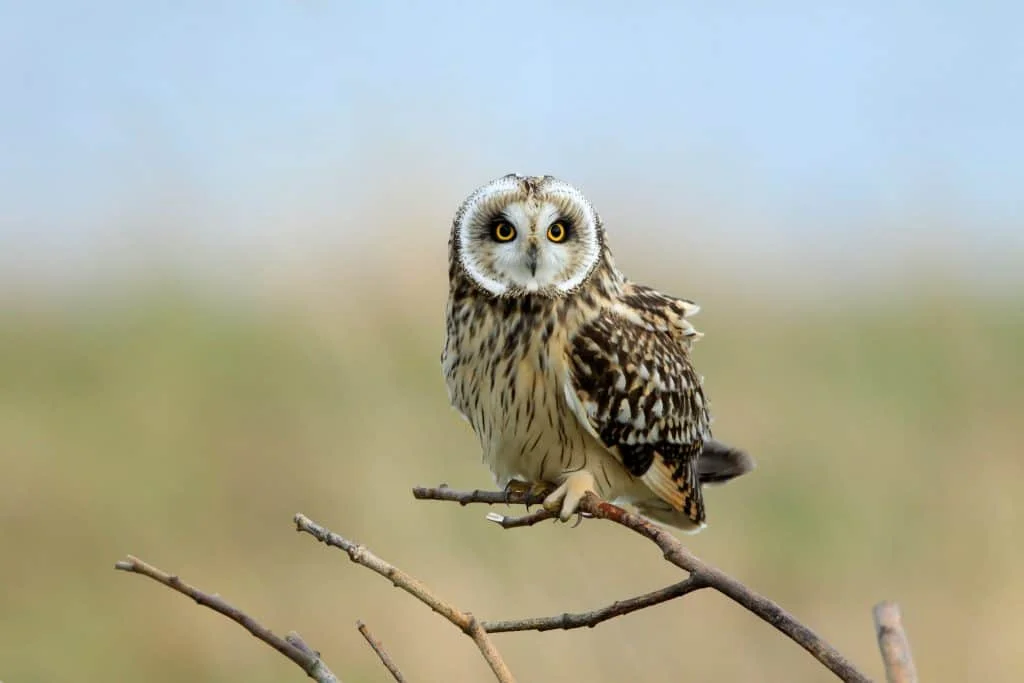
Wingspan
85 to 110 cm
Weight
206–475 g
Life Expectancy
4-12 years
Diet
Voles, Mice, Squirrels
Short-eared owls have no visible ear tufts which is how they got their names.
Their stocky bodies are covered in brown feathers and have patches of white.
These owls will hunt during both the day and the night and will use their habitats od open grassland area to their advantage.
The open areas make it easier for them to spot and swoop down to their prey.
Short-eared owls form breeding pairs and are monogamous during the breeding season, although it is unknown as to whether these breeding pairs are long term or if they change every year.
Breeding pairs will make their roosts on the ground in areas of tall grass, they only tend to roost in trees during the winter months especially when it is snowy.
Males will feed the females whilst they are incubating the eggs and will also help defend their territory with a series of harsh calls.
Short-Eared Owls will often form loose colonies of lots of individuals that stay near each other throughout the year, even during the breeding season.
The Short-Eared owl has a very wide range and can be seen throughout the whole state of Colorado.
They are most abundant to the north of Colorado which is where they will often stay as permanent residents for the whole year.
In the central and southern areas of the state, you can only see these birds outside of the breeding season.
This also means that they are likely to be less active in these areas as males will need to hunt less frequently outside of the breeding season.
8. Snowy Owl
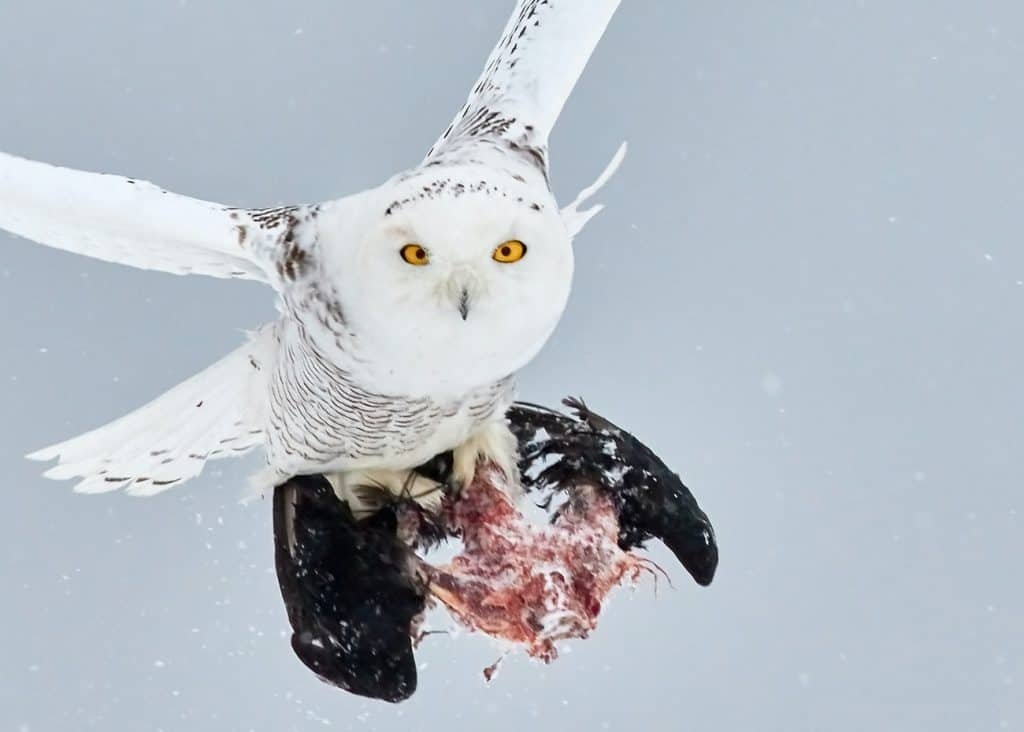
Wingspan
150 cm
Weight
2 kg
Life Expectancy
10 years
Diet
Birds, Rabbits, Fish & Rodents
These owls are covered in layers of thick white feathers and are on the larger side of the owl species.
They sometimes have individual speckling of black and grey on the tips of their feathers.
You are most likely to see one of these owls in tundra habitats and across open plains.
They are very defensive of their territory and are not afraid to get into fights with birds that move in too close.
There has been one reported occurrence of a pair of these owls even attacking an arctic wolf.
Snowy Owls will perch on high places such as telephone poles to observe their territory and search for prey more easily.
Males have a unique courting display that they do for the females which involves diving rapidly towards the ground with their wings in a v shape.
They will have a small prey item, such as a lemming, grasped in their talons and will drop it as a gift for the female when they reach close to the ground.
Apart from this, not a lot is confirmed about their breeding behaviours and it is uncertain as to whether they are monogamous or not.
These birds do not nest or spend their breeding seasons in the state of Colorado. They are irruptive visitors and usually just fly through.
That being said, the best chance to see these birds in Colorado is in the winter and the most sightings have been recorded to the north east of the state.
9. Long Eared Owl
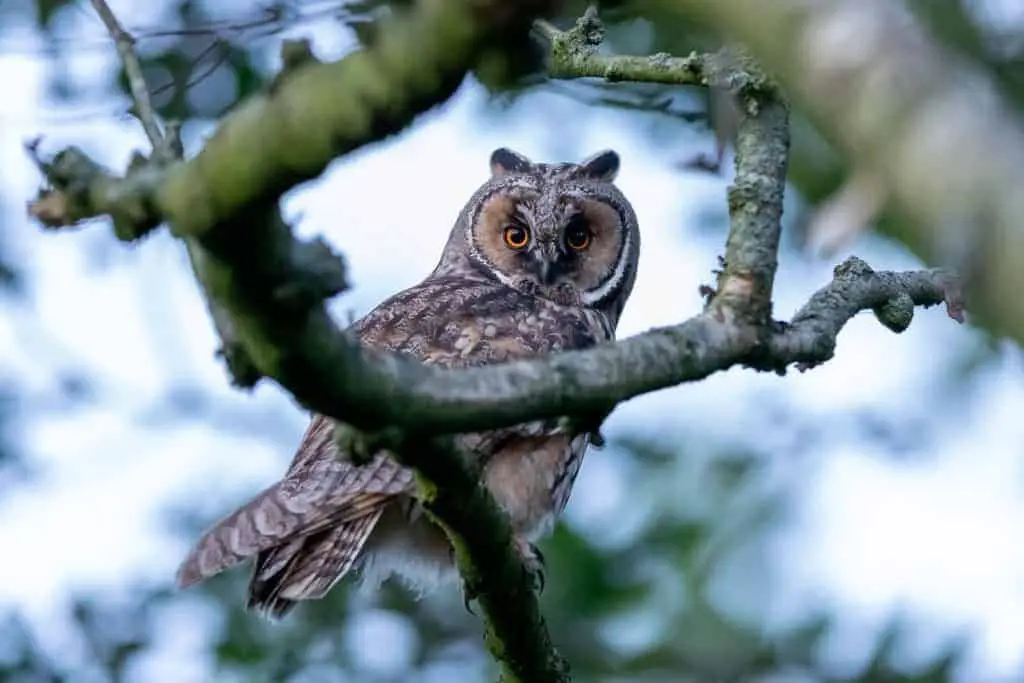
Wingspan
90 to 100cm
Weight
250 g
Life Expectancy
4 years
Diet
Small mammals, mice, rats & rabbits
The Long-Eared Owl has long and prominent feathered ears, which is unsurprisingly where it gets its name from.
They have black and brown feathers that cover their bodies and their faces are orange.
These owls like to roost in dense woodlands when they are breeding. outside of the breeding season will roost in loose colonies of up to 100 individuals.
During the breeding season these colonies will nest near each other, but they will not roost together.
These birds form breeding pairs and remain monogamous during the mating season.
That being said, it is unknown as to whether these breeding pairs are long term or if they form different breeding pairs each year.
Males will court the females by performing a series of complex, zigzag flights whilst producing a mating call.
In the western half of the state, these birds are more abundant and will stay in their home ranges year-round.
They can also be seen in the eastern half of Colorado but they are less frequent and only tend to go to these areas outside of the breeding season.
This also means they will likely be less active in these areas of the state as males need to hunt less outside of the breeding seasons.
10. Boreal Owl
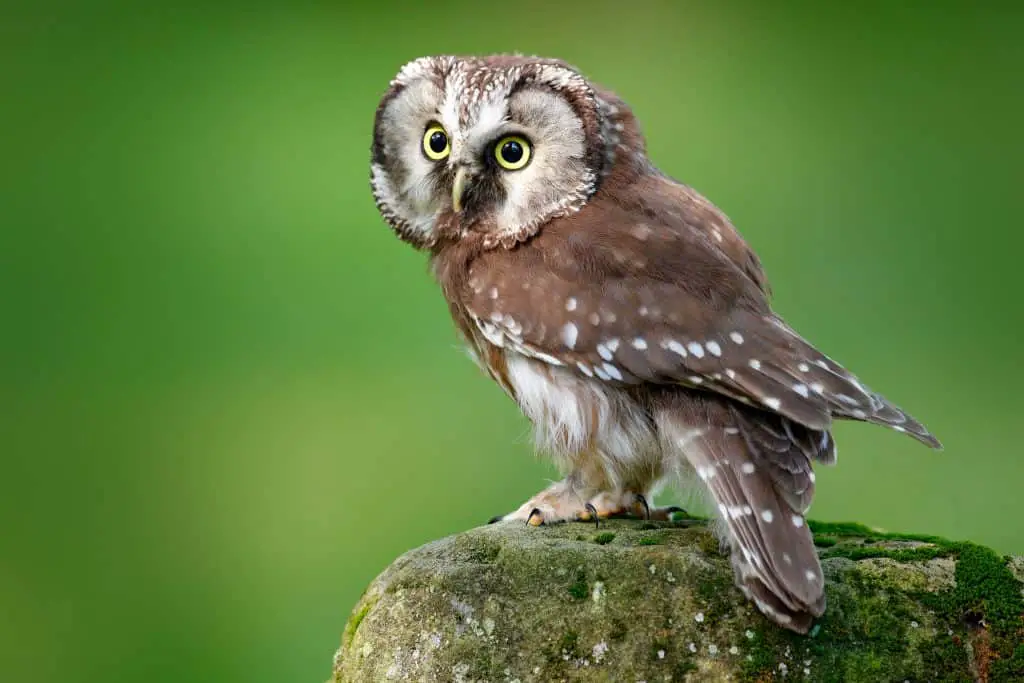
Wingspan
50–62 cm
Weight
120 g
Life Expectancy
16 years
Diet
Small mammals, birds & insects
The Boreal Owl is a small species of owl which has a square shaped head and no visible ear tufts.
Its tail feathers are short and it has a stocky body. Their feathers are a rich brown colour and they have white spots on their backs and white streaks on their belly.
Boreal owls are very solitary owls and even though they form breeding pairs, they do not roost together.
They will only interact for courtship, mating and feeding. These birds are monogamous but their breeding pairs change each year.
Males will act to defend their territory, but usually only the area closest to the nest cavity.
They will defend it will a series of calls and songs. These birds like to stay in a variety of woodlands and in America will often stay in woodland areas that are close to mountain ranges.
The Boreal Owl is a year-round resident in Colorado, though they are not as frequent as some of the other owl species that we have looked at.
They range from the north to the south of the state but tend to stick to the central areas.
Sightings close to the western or eastern borders of Colorado are very rare for this species of owl.
11. Northern Pygmy Owl
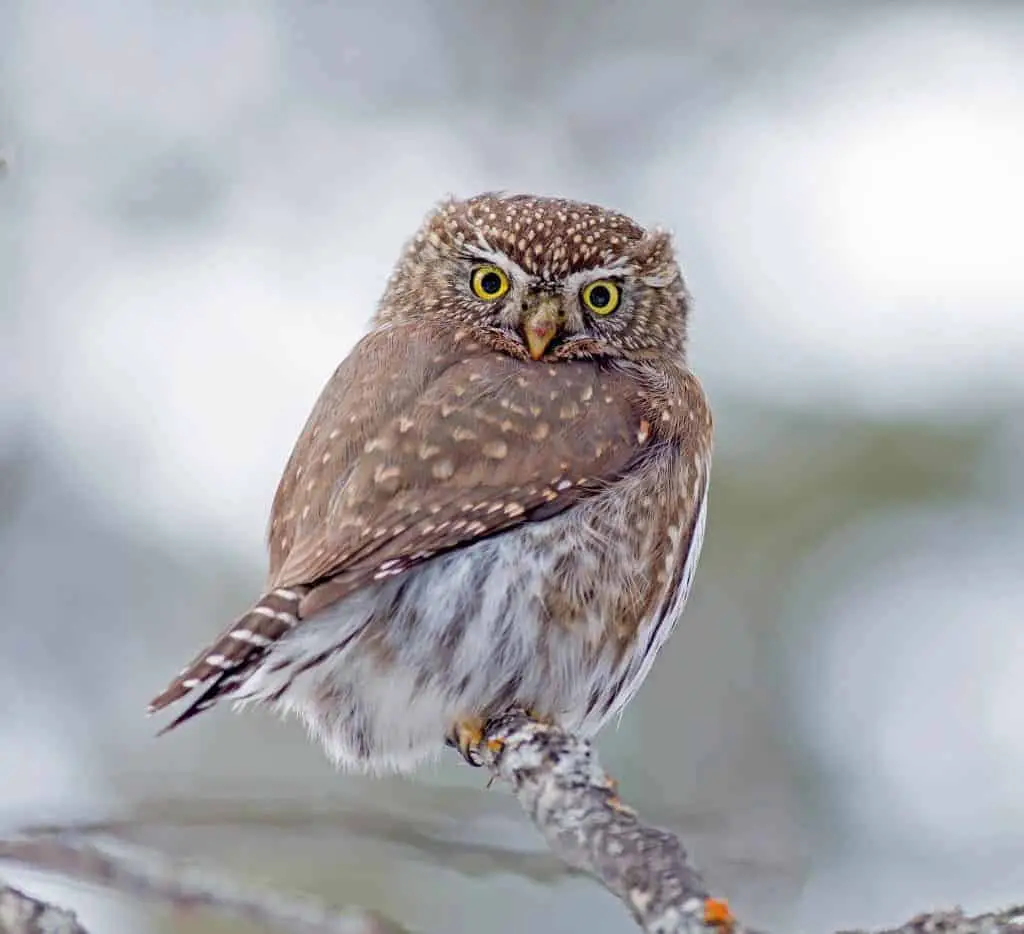
Wingspan
15 inch
Weight
2.25oz
Life Expectancy
6-7 years
Diet
Small birds
The Northern Pygmy-Owl is an adorable species of owl that is known for its spherical head and body. They are one of the smallest species of owl known to man.
You are most likely to see one of these owls in thick wooded areas but they have also been known to move into suburban towns during the winter months.
Due to the fact that they are often preyed on by bigger species of owls, these birds hunt during the day to avoid confrontations with most night hunting owls.
During the breeding season, males will attract females to their territory with their unique tooting call.
These birds are monogamous and males will help the females raise the brood. However, it is unknown as to whether these breeding pairs are long term or if they change every year.
Northern Pygmy-Owls cannot be seen across the whole of Colorado, but the ones that make their nests in the state are permanent residents and will stay in Colorado year-round.
These nesting ranges have been reported to be in the central and south west of the state.
In the winter months you are more likely to see them in Colorado towns, hunting songbirds that have gone into people’s garden to use bird feeders.
12. Burrowing Owl
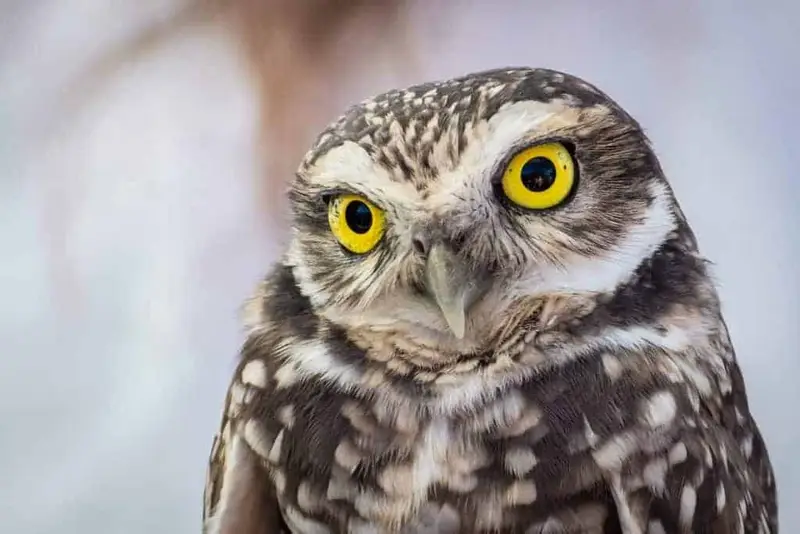
Wingspan
51-61 cm
Weight
140-240 g
Life Expectancy
10 years
Diet
Large Insects and Small Rodents
This small species of owl has brown feathers and sometimes has large patches of white on places such as its belly.
Burrowing Owls are monogamous during the breeding season and large numbers of these birds will form loose colonies that stay together.
Whilst it is not known whether they form long term breeding pairs, it is known that females protect the eggs and stay in the burrow whilst males defend the territory using their specific calls and wing displays.
These birds hunt during both the day and the night and prefer to stay in open areas of land such as treeless grasslands.
These birds are most abundant in Colorado during their breeding season. This is also when they are most active so it is a good chance for you to see them.
They have been recorded to make their breeding nests and territories throughout the whole state of Colorado.
The most abundant number of sightings of these nests is in the western regions of the state.
13. Spotted Owl
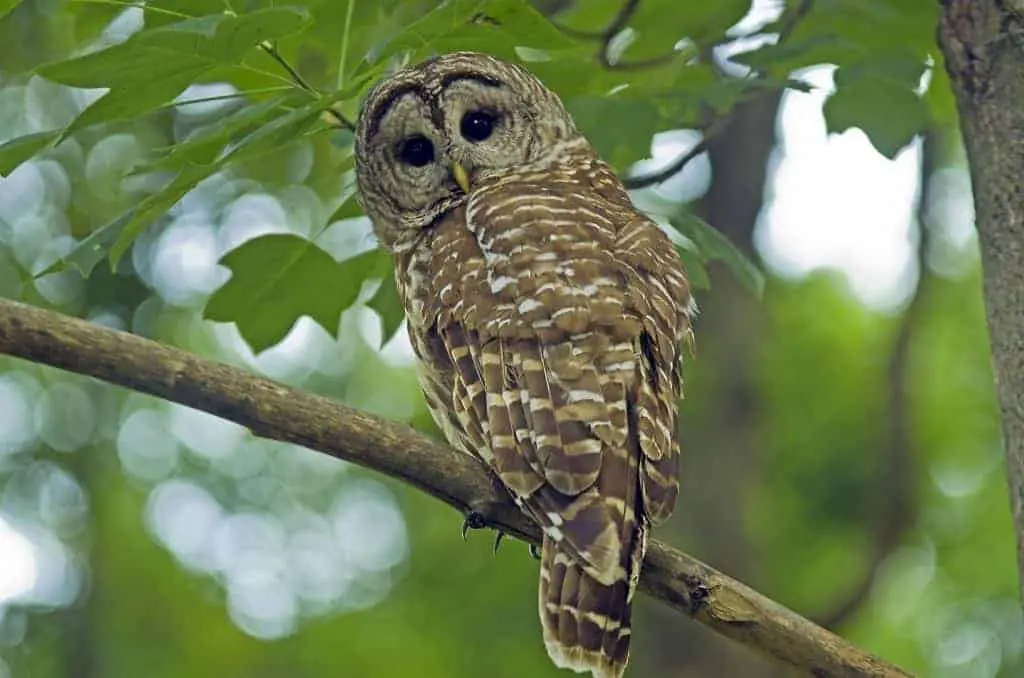
Wingspan
114cm
Weight
600g
Life Expectancy
16-21 years
Diet
Small mammals
The Spotted owl gets its name from the frequent white spots that appear on its pale brown feathers.
It is a large species of owl that has no visible ear tufts. There are two sub-species of this owl, The Mexican Spotted Owl and the Northern Spotted Owl.
Both subspecies of Spotted Owls are happy to make their habitats in a variety of woodlands but they prefer mature forests with denser canopies.
These birds are solitary, although they do form breeding pairs and look after their young for the first few months of their lives.
The breeding pairs are long term and whilst they do not interact with each other outside of the breeding season, they will both stay in their home ranges for the whole year.
Spotted Owls do not fly long distances and migrate to deal with the weather changes, instead they move to different layers of the forest canopies to control their body temperature.
The Mexican Spotted Owl is the sub-species of Spotted Owl that you will find in the state of Colorado.
Whilst their breeding ranges appear to be shifting, there have been recorded nesting sites in both the central and southern areas of the Colorado state.

More Articles.
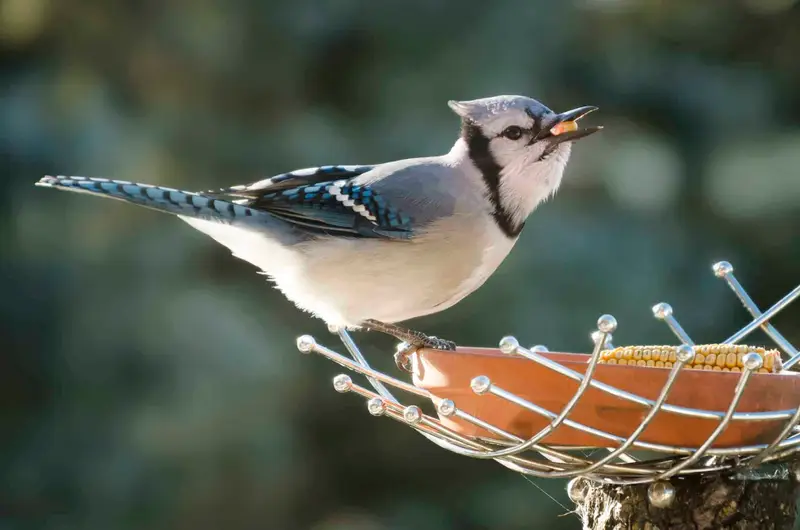
How to Attract Blue Jays to your Yard?
Some may vehemently argue that Blue Jays are the bullies of the bird kingdom and
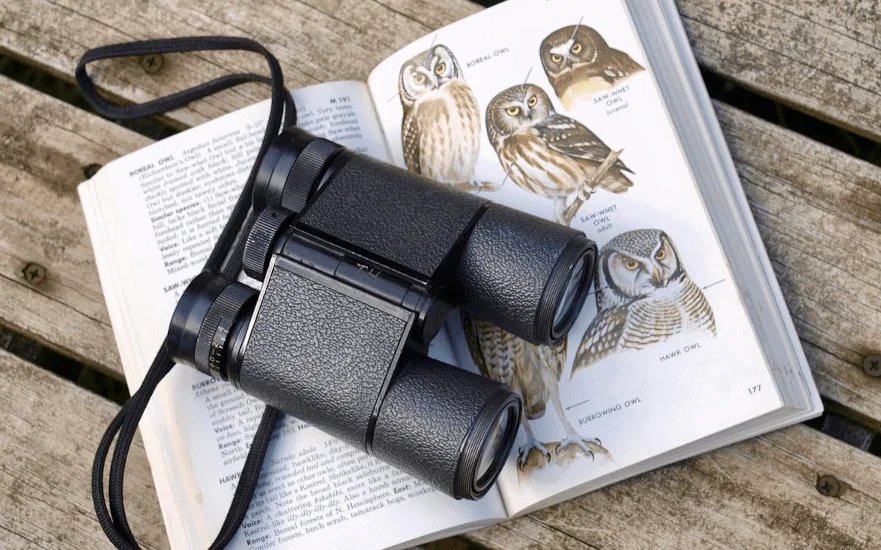
Best Binoculars for Bird Watching 2020
Article Summary: Best Budget Binoculars: Nikon 8250 Aculon 16×50 Best Mid-tier Binoculars: Nikon Monarch 5
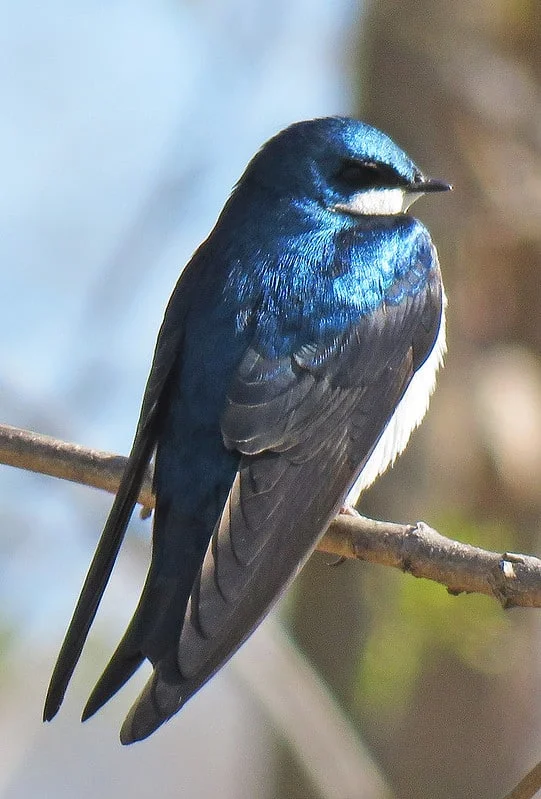
North American Birds with Blue Wings (13 Species with Pictures and Sounds)
North America is filled with many wonderful birds with blue wings – in fact, there

About Us
We are avid bird-watchers who recently retired, allowing us more time to travel the world. Fortunately, we have managed to visit numerous countries around Europe, Asia, and America. Watching and photographing birds has been a passion for many years and we are making the most of the extra time on our hands!
